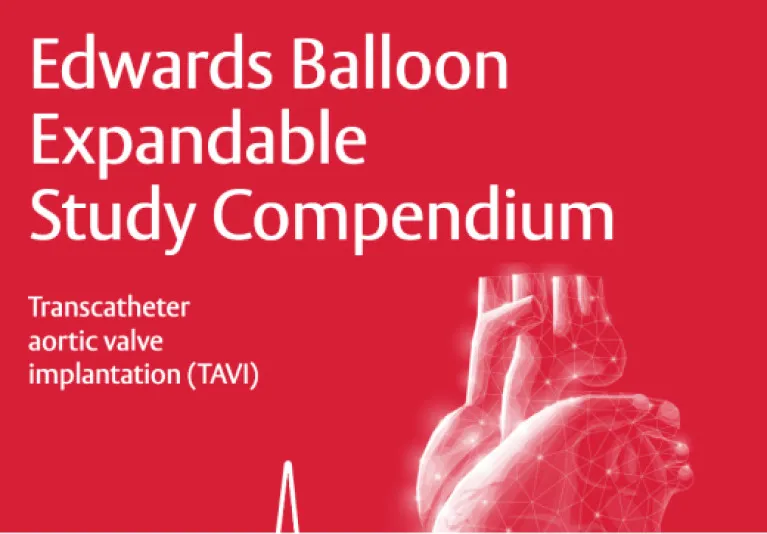PARTNER 1A Trial - TAVI shows similar outcomes compared to sAVR1-3
- A large, multicentre trial enrolling high-risk severe aortic stenosis (sAS) patients randomised to either TAVI or sAVR
- The rate of death (primary endpoint) was non-inferior with TAVI and sAVR at 1 year
- TAVI significantly improved KCCQ overall summary score from baseline at 1 month, 6 months and 12 months in patients receiving transfemoral TAVI
The PARTNER 1A Trial study design1

Inclusion and exclusion criteria
Inclusions1
- Severe aortic valve stenosis (aortic valve area <0.8 cm2 or mean gradient >40 mm Hg or peak velocity >4.0 m/s)
- Cardiac symptoms (NYHA class ≥II)
- High surgical risk (risk of death or irreversible severe morbidity at least 15% according to the assessment of a heart team of cardiologists and cardiac surgeons – STS score ≥10)
Exclusions1
- Evidence of an acute myocardial infarction ≤1 month before the intended treatment
- Aortic valve is a congenital unicuspid or bicuspid valve; or is non-calcified
- Mixed aortic valve disease (aortic stenosis and aortic regurgitation with predominant aortic regurgitation >3+)
- Any therapeutic invasive cardiac procedure performed within 30 days of the index procedure, (or 6 months if the procedure was a drug eluting coronary stent implantation)
- Pre-existing prosthetic heart valve in any position, prosthetic ring, or severe (greater than 3+) mitral insufficiency
Baseline characteristics
The baseline characteristics of the patients in the TAVI and sAVR groups were generally well balanced1*
* Plus–minus values are means ±SD.
† Scoring on the risk model of the Society of Thoracic Surgeons (STS) uses an algorithm that is based on the presence of coexisting illnesses in order to predict 30-day operative mortality. The STS score equals the predicted mortality expressed as a percentage. Less than 5% of patients in the population on which the STS algorithm is based had a predicted operative mortality (risk score) of more than 10%.
‡ To convert values for creatinine to micromoles per litre, multiply by 88.4.
Reported clinical and patient outcomes
Primary endpoint with added 5-year follow-up data
At 1 year:1
- All-cause mortality occurred in 84 patients (24.2%) in the TAVI group versus 89 patients (26.8%) in the sAVR group (p=0.44)
A 5 years:2
- All-cause mortality occurred in 67.8% of patients in the TAVI group versus 62.4% of patients in the sAVR group (p=0.76)
TAVI versus surgery in high-risk patients2

* Prolonged follow-up
Quality of life
Patients receiving transfemoral TAVI enjoyed an improved health status at 1, 6 and 12 months after the procedure from baseline, as measured using the KCCQ (Kansas City Cardiomyopathy Questionnaire – Overall Summary).3

The rapid recovery from transfemoral TAVI was associated with short-term benefits in health status at 1 month. Based on the 6 and 12-month score difference, TAVI also provided meaningful, late health status benefits.3
Find out more about the QoL analysis and see the full outcome data
Real-world data
Source 3 registry5-7
- 1,950 sAS patients from 80 centres in 10 countries were enrolled between July 2014 and October 2015
- Inclusion criteria included patients suffering from severe, symptomatic, calcific AS, STS Score ≥8 and a Logistic EuroSCORE ≥15
- With TAVI, the rate of death at 30-days (primary endpoint) was low (2.2% overall, 1.9% transfemoral access vs 4.0% non-transfemoral access, p=0.0023)
Clinical implications
What could a TAVI referral mean for your patients who match the PARTNER 1A trial characteristics?
- For high-risk patients with sAS, TAVI offered similar chances of survival compared with sAVR even after five years of follow-up1,2
- This could mean the difference between a life well lived and a life of compromises3
References:
1 Smith CR et al. N Engl J Med 2011;364:2187-2198 and supplementary material.
2 Mack MJ et al. Lancet 2015;385:2477-2484.
3 Reynolds MR et al. J Am Coll Cardiol 2012;60:548–558.
4 Edwards Lifesciences. Data on File.
5 Wendler O et al. Circulation 2017;135:1123-1132.
6 Wendler O et al. Eur Heart J 2017;38:2717-2726.
7 ClinicalTrials.gov. Identifier: NCT02698956. Available from https://clinicaltrials.gov/ct2/show/NCT02698956 (accessed September 2020).
Medical device for professional use. For a listing of indications, contraindications, precautions, warnings, and potential adverse events, please refer to the Instructions for Use (consult eifu.edwards.com where applicable).
PP--EU-0772 v2.0
